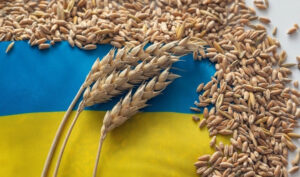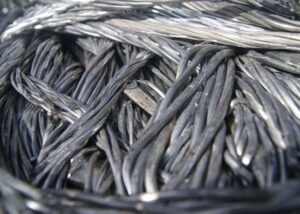
Ukraine has exported 34.451 mln tonnes of grains and pulses since the beginning of the 2024-2025 marketing year (July-June), of which 1.627 mln tonnes have been shipped since the beginning of the month, the press service of the Ministry of Agrarian Policy and Food reported, citing the State Customs Service.
According to the report, as of April 25 last year, the total shipments amounted to 40.289 million tons.
At the same time, since the beginning of the current season, Ukraine has exported 13.623 mln tonnes of wheat (15.404 mln tonnes in 2023/24 MY), 2.247 mln tonnes of barley (2.178 mln tonnes), 10.8 thsd tonnes of rye (1.2 thsd tonnes), and 18.067 mln tonnes of corn (22.231 mln tonnes).
The total export of Ukrainian flour since the beginning of the season as of April 21 is estimated at 57 thsd tonnes (in 2023/24 MY – 85.7 thsd tonnes), including wheat – 52.9 thsd tonnes (81 thsd tonnes).

Ukraine reduced imports of nickel and nickel products by 49.3% to $3.9 million in January-March 2025.
In March, imports amounted to $1.92 million.
Exports of nickel products tripled to $361 thousand compared to $94 thousand last year, including $328 thousand in March.
In 2024, imports increased by 73.7% to $26.73 million, while exports rose to $602 thousand (+13%).
Nickel is used in the production of stainless steel and for nickel plating. Nickel is also used in the production of batteries, powder metallurgy, and chemicals.

In January-March 2025, imports of aluminum and aluminum products increased by 18.5% to $116.75 million, including $42.16 million in March.
Exports during this period increased by 35.5% to $31.7 million ($11.74 million in March). At the end of 2024, imports amounted to $446 million (+21.7%), while exports amounted to $124.4 million (+27.4%).
Aluminum is widely used as a structural material. The main advantages of aluminum are its lightness, stamping resistance, corrosion resistance, high thermal conductivity, and non-toxicity of its compounds. In particular, these properties have made aluminum extremely popular in the production of cookware, aluminum foil in the food industry, and packaging. The first three properties have made aluminum the main raw material in the aviation and aerospace industries (recently it has been replaced by composite materials, primarily carbon fiber). After the construction and production of packaging, such as aluminum cans and foil, the energy sector is the largest consumer of the metal.

In the first quarter of 2025, imports of lead and lead products to Ukraine increased 7.4 times to $2.09 million ($863 thousand in March).
Exports decreased by 25.2% to $2.12 million ($773 thousand in March).
In 2024, imports also increased by 2.4 times to $2.39 million, while exports fell by 22.9% to $11.4 million.
Lead is currently mainly used in the production of lead-acid batteries for the automotive industry. In addition, lead is used to make bullets and some alloys.

In 2025-2026 marketing year, the export of rapeseed from Ukraine may decrease to the lowest level since 2022-2023 MY and will amount to about 2.7-2.8 mln tonnes, down 13% compared to the current season, according to APK-Inform news agency.
The analysts noted that the reason for such a decrease is the expected decrease in oilseed production, as well as a possible increase in demand from the processing industry.
According to experts, in 2025, the production of rapeseed in Ukraine may decrease to the lowest level since 2022 due to the reduction of winter crops area as a result of moisture deficit in the fall of 2024 and poor wintering of crops in a number of major crop producing regions. In addition, cold weather, frosts and snow in the first decade of April may significantly worsen the situation.
According to APK-Inform estimates, the planted areas under rapeseed are 1.34 mln ha (-4%), while the harvested area may not exceed 1.17 mln ha (-10%) and may be even lower due to unfavorable weather conditions. The forecast of oilseed production in 2025 is about 3.35-3.4 mln tons (-8%).
As for the distribution of rapeseed in the new season, analysts believe that the situation will largely depend on the tariff policy of China and the US.
“We are currently witnessing the deterioration of trade relations between the US and China, the US and Canada, and between China and Canada, which will lead to the redistribution of trade flows of canola and processed products, and may change farmers’ plans for sowing this crop in major regions,” the agency said.
Several countries may try to replace Canadian oil and meal on the Chinese market by increasing production of rapeseed/canola, but the question is in the timing – the products are already in short supply and China needs to increase supplies now, not in the new season.
Due to the trade wars, China is expected to increase its demand for Ukrainian rapeseed oil and meal in the new season, which may increase domestic processing, but it will depend on the ratio of the cost of raw materials and oil on the Ukrainian market. In addition, it may be more difficult for Ukrainian companies to build up stocks, as farmers are in no hurry to sell raw materials under forward contracts.
“The trade may remain weak until the impact of frost and snow on the oilseeds in a number of European countries and in Ukraine in particular is assessed. It is also important to keep in mind that if the situation with tariffs does not change before the new season and all duties for Canada remain in force, Canadian canola may increase its presence on the European market, and, therefore, the window for the Ukrainian oilseed remains limited to the first half of the season,” APK-Inform summarized.